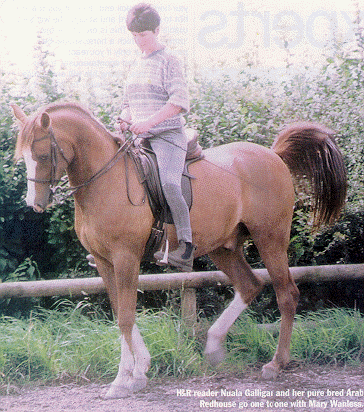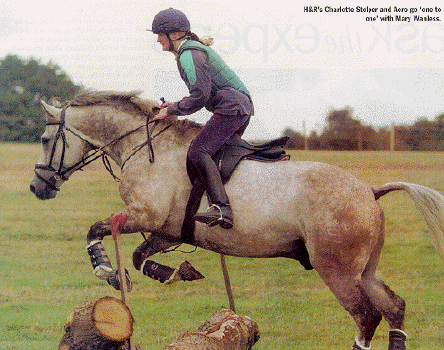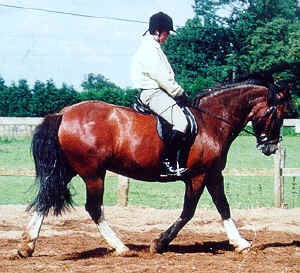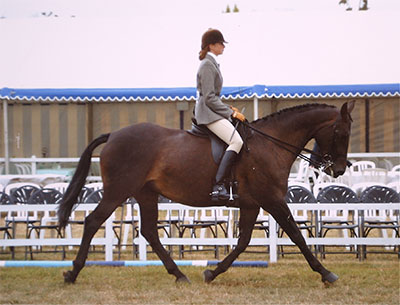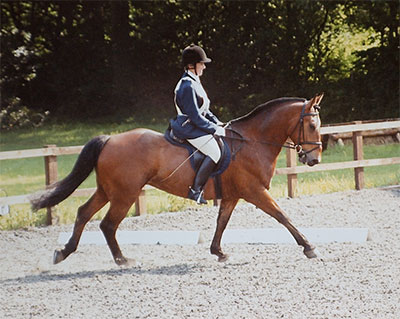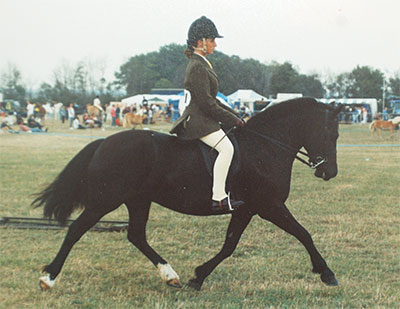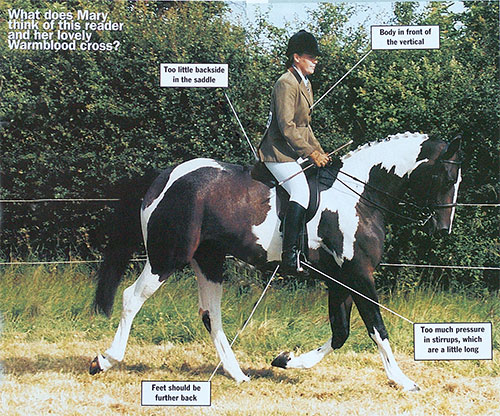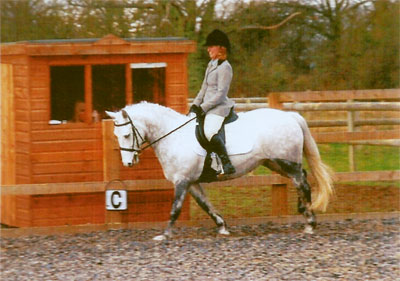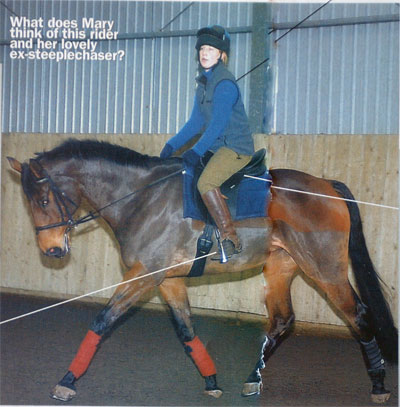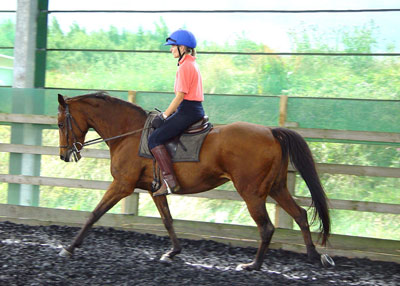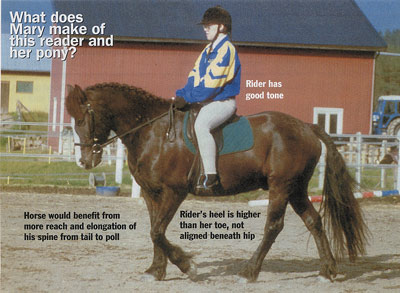RWYM
ARTICLE 14
 I have virtually no information about this horse and rider, other than a short note which says ‘My riding has been so wrong for all these years, please help. My leg jigs about all over the place’. It is signed, ‘Confused Rider’.
I have virtually no information about this horse and rider, other than a short note which says ‘My riding has been so wrong for all these years, please help. My leg jigs about all over the place’. It is signed, ‘Confused Rider’.
From the length of the rider’s stirrups, the proximity of the show jump, and the use of the short whip, I imagine that jumping is her passion. Her horse looks to be a warmblood who I imagine is a very sweet soul, but a lot of horse to ride. We see him here in walk, and he is rather hollow. He looks to be a soggy ‘unstuffed’ horse, which makes me suspect that he has quite a lumbering trot, and that he would need to go strongly forwards more before his back end and his front end could become ‘connected’. In saying this, I am taking inspired guesses which might well be wrong.
Our confused rider sounds rather desperate, but I think that she may have far more going for her than she has ever realised. She could well be obeying some of the basic tennets of rider biomechanics, but not knowing that she is doing so! There is a lot in this photograph which is happening right – albeit not yet right enough to have caused the horse’s back to come up and his neck to reach into the rein. The line of the rider’s spine is more correct than one often sees, and her back is neither hollow nor rounded. Her seat bones will be pretty close to pointing down, and her next step would be to notice whether her armpits are more closed at the front or more closed at the back. You can see in the photograph that they are more closed at the front – although gaining this information through reading this article will not help our rider. She will need to make a point of noticing for herself that this is true, and then of deliberately closing her armpits at the back. She may also need to lengthen her reins, since her arms and hands will then not reach so far out in front of her. After about 10,000 repetitions (that’s 10,000 times of noticing, ‘Oh-ho, lost it again.’ and then making the correction) her body will habituate to the new norm.
She has an unusually good ‘square bum’. Look at the underside of her thigh, and the point where her thigh meets the vertical line of her lower back. Compare it with the rider in last month’s article, where the thigh meets the backside in a curve rather than a point. This month’s rider has her ‘back corners down’, and if this happens for her naturally she is extremely lucky – it took me years to work out how to get my backside to take on this shape! This facet of good rider biomechanics happens naturally for many male riders, but for few women, and it brings with it some big advantages.
The line of the thigh is also good, and it looks very ‘stuffed’ and strong. The rider is supporting her weight all the way down her thigh, and not just on her backside. She is not sitting as if the horse were an armchair, but is sitting more as if on one of those stools which are good for your posture, where you sit on a slope and rest your shins on a slope.
Whilst the thigh and torso look strong and toned, the lower leg looks less so. The foot is not far enough back underneath the rider for her to land on the riding arena on her feet if we took her horse out from under her by magic. But it is more correct than one often sees in jumping riders who have their stirrups this short. Her heel may be slightly above her toe; I have less of a problem with this than most teachers, and am pleased to see that she has not jammed her heel down and forward as so many riders do. This could mean that over a fence her lower leg swings back, and that she will need – at this point in time – to have more weight in her heel. But on the flat pushing the heel down and forwards creates far more problems than it cures (as I have explained in previous articles).
The rider states that her leg jigs about all over the place, and the lack of muscle tone in her calf will lie at the root of this. A useful exercise which you can do as you read this, is to reach down and put your fingers around one of your ankles, with your thumbs on your Achilles tendon. Rest your fingers against the five tendons at the front of the ankle, which connect with each toe. Then stick out all of the tendons against your fingers. What happens to your toes? I think you will find that they spread out and come up against the top of your boot.
Put one hand on the back of your calf as you do this, and one hand on the inside of it, and feel how sticking out the tendons makes the muscles of your calf bulk out. You then want to maintain this higher tone as you ride. Stabilising the lower leg is notoriously difficult for people who lack muscle tone in the calf. This exercise is unlikely to completely solve the problem, but it is often a great help in developing good rider biomechanics in the lower leg.
Given that this rider has a lot working right, why is she so confused and possibly even desperate? The answer could lie with what goes on inside her head as she rides. Even with a body which naturally works well, it is possible to not have your brain operating well enough to ‘put two and two together’ and fathom out how the rider/horse interaction works. One of my colleagues in America, who has ridden on their international dressage team, once told me after she had been working with me for about five years that ‘I never realised that you had to teach people how to pay attention – I though that everyone concentrated just like I did’. She could not have been more wrong.
She had been in the opposite situation, of having phenomenal focus and intention, but not such good biomechanics. A well functioning brain can make up for a malfunctioning body, but the compensation does not work so well the other way round.
It is also possible for a naturally talented rider not to realise just how much you have to ‘go for it’, or to be to be put off the scent by bad teaching which encourages the rider to focus on the wrong things. I know several young, talented riders who this has happened to. I also know a couple of riders who have well deserved reputations for starting young horses and riding them well. But both of them meet their Waterloo when they decide that the horse is going well enough that it’s time to ‘do dressage’. So they lengthen their stirrups (too much), throw their natural skills out of the window, and begin to do it wrong. Riding then stops feeling like quite so much fun, and very soon they can’t wait for someone to send them another young horse to ride – whereupon they revert to the rider biomechanics they naturally use, thus doing it right!
If this rider were to take lessons from someone who understood the biomechanics of riding, I think she would make progress very quickly. She has less to undo than many riders, and undoing one’s wrongness is the hardest part of learning. The base lines which she has to build on are not too far off, and this should help her to discover and understand how to use her body as a tool to shape the horse. I hope she can get the help and clarity that she wants.


